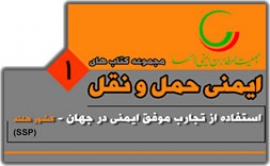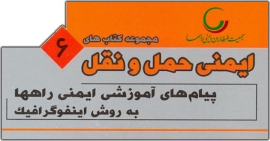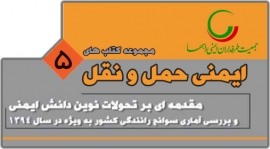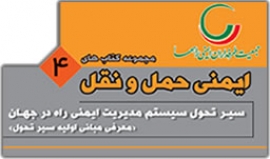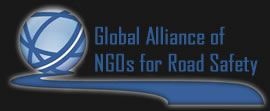From mid-90’s widespread changes have occurred in the theoretical principles and executive policies for road safety which, despite its development and completion in the later decades, these principles were applied almost in all the developed and industrialized countries.
The origin of this theoretical-executive thinking took shape in Sweden which is also considered one of the most successful countries in the field of promotion of road safety in recent decades. This program dubbed ‘Vision Zero” is known as a casualty and death free landscape in road traffic and is indicative of the backdrop of a safe future in which despite the occurrence of accidents no one will be killed or disabled in traffic accidents. This vision was first raised in Sweden in 1995 and in the cosecutive years, i.e. 1997 and 1998 was approved by the Swedish Parliament as the executive basis for management of road safety and afterwards was implemented by many other countries.
The most important feature of this approach and line of thinking is the revision in responsibilities caused by driving accidents and death of the people which began with the motto “Don’t blame the victims”.
On the basis of this thinking transportation is a cross-sectoral and integrated system and those who design, manage and operate components of the transportation system, such as car manufacturers, transportation companies and agents, politicians, legislative authorities and, finally, police, etc. are mainly responsible for the driving accidents and deaths. But before that evolution and policy revision, and similar to what is currently in common in our country, almost all the responsibility of traffic accidents is shouldered by the person using the road or in other words the victims of the road crashes.
Is Death the Penalty for A Traffic Mistake by the User!?
Basically, the road transportation system has not been based on this reality that human beings are not machines and sometimes they may be affected by wrong feelings or mistakes and to sum it up: “man is fallible”. In the meantime, we know in many cases small and simple mistakes may result in the death of road users. For this same reason, today and after almost two decades, studies and macro investments in the field of automation of road navigation and use of intelligent systems in driving vehicles have been put on the agenda of many research centers and producers (including in our country).
The VZ theory emphasizes on the point that all the constituent factors of the transportation system are interconnected, and have mutual interactions. Fatalities or severe injuries mean that the components of the road transportation system have not functioned properly.
This new systematic outlook has brought about changes in the executive policies and programs of road safety and has left great emphasis on the coordination of factors, including the design of the automobile and the road environment based on behavioral and physical limitations of human beings.
This reality can never be denied that first of all humans are fallible and secondly, traffic accidents cannot be completely prevented; therefore transportation system should be designed and regulated in a way that each simple traffic mistake by the people will not be responded or punished by deaths or severe injuries.
Evolution of Safety Knowledge and Literature in the World
During the past two decades and in many countries, particularly in the industrial world and even some developing countries the road safety condition has been completely brought under control. Moreover, the issue of road safety has become a fully scientific topic and today widespread and formulated knowledge and experiences exist in the world in this regard. In addition to effectively reducing road fatalities they have also developed overall and fundamental changes in the thinking, strategy and executive programs of promoting road safety, and blocked the way to any operations based on trial and error. Naturally, failure to use the global knowledge and experience in the field of road safety in our country will have no outcome other than material and mental losses. It will also mean the loss of thousands of human lives per year and increase in the number of the poor and households without breadwinners.
As it was mentioned, among experiences and successful programs on road safety over the past two decades, reference can be made to Sweden’s Vision Zero or the Netherlands Sustainable Safety Program. Meanwhile, in March 2010 the United Nations General Assembly in Resolution 64/255 announced 2011 to 2020 the Decade of Action for Road Safety to improve global road safety. The mission was followed by the World Health Organization (WHO) which in cooperation with the United Nations Road Safety Collaboration published the executive program on promotion of safety in that decade as a guideline for the use of all countries of the world. The full text of the report was published on the website of the Road Safety Supporters Society and is at the disposal of those interested.
In brief, it can be said that the theoretical principles of the new global road safety policies are based on the two main bases:
First application of the deterrent approach and proactive approach for the prevention and control of unsafe and high-risk human behaviors and second designing and regulating the transportation system as such that it would have the capacity of generosity and accountability to the behavioral and physical shortcomings of human beings.
Therefore, in modern road safety thinking and literature, first the responsibility of the road accidents and creation of a safe traffic should not only be shouldered by the users but rather those who design, manage and control the transportation system are mainly responsible for driving accidents and fatalities. Secondly, the main axis in the compilation of new road safety policies should be inclined towards human beings and paying attention to their physical and behavioral restrictions.
Hence in the formulation of safety programs first physical vulnerability of human beings in traffic accidents should be considered and accepted by relevant authorities, and second attention should be paid to the limitation of the human behavioral capacity (the fact that human beings are fallible), and third should consider limitations and shortcomings of human behavior (for example, the fact that human beings are not always committed to rules and regulations).
The fundamental principles and foundation of the universal program for safety decade of the United Nations is based on the same thinking and has been compiled on the basis of the safe system approach. In this method, the goal is to make the road transportation system more tuned with human errors and pay attention to the physical vulnerability of human beings. This principle begins with the acceptance of the reality that human errors and consequently road accidents are unavoidable and cannot be completely avoided. Therefore, the objective of the safe system is that in road accidents there would be no major injuries or they would be minimized and attention would be paid to the human physical restrictions (especially the kinetic energy of human body) and it will be considered as the main and important basis in designing of the road transportation system.
In this regard, it is noteworthy to know:
• Many people, if driving in a car with 30 km/h speed, will survive in car accident
• Many people, if driving in a car with 50km/h speed, will be killed in car accident
• A safe car is capable of supporting the life of its occupants up to the speed of 65 to 70 km/h in frontal collisions and 45 to 50 km/h in collisions from the sides, on condition that all the occupants fasten their seat belts.
Leave a comment
Make sure you enter the (*) required information where indicated. HTML code is not allowed.
